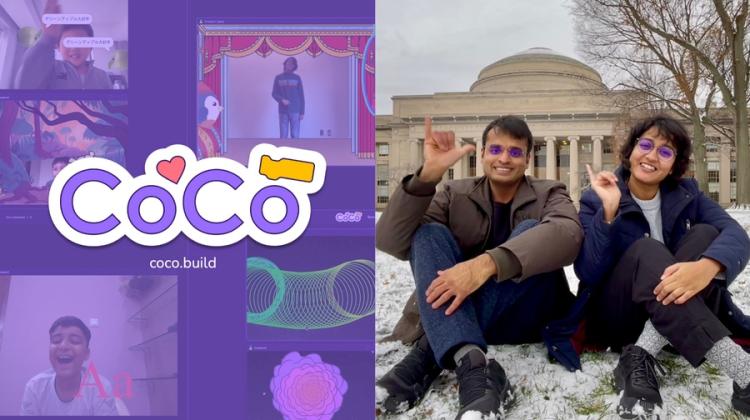CoCo: A real-time co-creative learning platform for young people

Shruti Dhariwal (right) and Manuj Dhariwal, PhD students at Media Lab’s Lifelong Kindergarten research group, created CoCo — a new platform for young people to co-create, code, and collaborate with peers in real-time. Educators from 68 countries have signed up to receive the beta release. Image courtesy of the researchers.
By MIT Media Lab
CoCo is a new co-creative learning platform that empowers educators to engage children and teens in an endless variety of collaborative creative computing experiences with peers — regardless of whether they are sitting next to one another in a classroom or connecting remotely across continents.
The platform supports real-time collaboration across multiple types of interactive environments, including those for block-based coding, text-based coding, digital art, and creative writing. The co-creative programming environments in CoCo currently extend and build on top of Scratch 3.0, developed at the MIT Media Lab, and p5.js, inspired by Processing, which also originated at the Media Lab.
Ten years of being creative together
Shruti Dhariwal SM '18 and Manuj Dhariwal SM '18, co-creators of the CoCo platform, have been long-time creative partners in both work and life. A decade ago, as newlyweds, they co-designed social and educational board games in India, which were used by 3,000 schools across the country and reached over 300,000 families. For Manuj and Shruti, the most rewarding aspect of their work was seeing how these games engaged children in “shared joyful experiences” — a theme that continues to inspire their current work and interests.
In 2015, the couple relocated to Cambridge, Massachusetts, to pursue graduate studies at MIT. Shruti became a master’s student in the Lifelong Kindergarten research group at the Media Lab. Manuj joined Shruti at the Media Lab after completing his master's thesis jointly with the Department of Electrical Engineering and Computer Science and the Department of Brain and Cognitive Sciences.
The pair now continue to collaborate together as PhD students at the Lifelong Kindergarten group, which has been a leader in developing creative learning technologies and communities for young people for more than three decades. Lifelong Kindergarten has been responsible for widely known projects including LEGO Mindstorms, Computer Clubhouse, Scratch, and others.
Inspiration for CoCo
In February 2019, while volunteering at a mindfulness retreat for children, the Dhariwals interacted with a group of 8- to 12-year-olds who revealed that they spent hours playing online multiplayer shooter games every day. The reason? As one of the kids said, there was “nothing else to do,” and immersing himself in these games helped him avoid feeling lonely in the evenings until his parents came home from work.
This exchange and the context in which it occurred prompted the Dhariwals to reflect on two key questions later that day:
- How can young people engage in diverse constructive learning experiences online (beyond playing games) while also feeling authentically connected with their peers in real-time?
- How can we envision anxiety-free social platforms for children and teens that are intentionally grounded in the core principles of mindfulness such as non-judgment, interconnectedness, and compassion?
It was in this conversation, which was coincidentally full of words starting with “co” that the name and ideas of CoCo first took form.
Designing for knobs over switches
Existing digital creative tools typically follow one of two collaboration approaches: working individually on a project, then sharing online; or working together on the same project, as in a Google Doc.
With CoCo, the Dhariwals introduced the design principle of “knobs over switches” to envision a new type of co-creative digital environment that bridges the gap between the above two extremes. Instead of exclusively focusing on “working together,” CoCo spaces are designed to support multiple ways of “being together.” Creators can opt to work independently alongside others, share code and media with each other in real time, or build collaborative creations.
CoCo is also consciously designed as a “self-less” social platform that departs from the widely prevalent individual-centric paradigm (of profiles, likes, followers, etc.), rooted excessively in the ideas of comparison and gamification. In CoCo, the fundamental unit in the system is not the individual user, but instead the co-creative spaces where young people engage in with peers.
Interest from around the world
Educators and organizations from 68 countries have already signed up to receive the beta release, expressing their excitement to use CoCo within their classrooms and communities.
An educator from Spain writes, “CoCo opens up a whole new way to collaborate on creative computing projects.” Another teacher, from San Francisco, notes, “Co-creation tools for students are rare and have lots of potential across subject areas and grade levels!”
Eric Rosenbaum SM ’09, PhD ’15, a graduate of the Lifelong Kindergarten group and the co-inventor of Makey Makey, calls CoCo an “incredible new work on collaborative creativity.”
Reacting to the feedback, Shruti Dhariwal says, “CoCo really has been a labor of love for us so it has been super encouraging to see all the positive reactions.” Given the widespread interest in the platform from educational organizations around the world, the Dhariwals hope to explore ways of scaling this work further so they can make CoCo available for communities everywhere.
“Being. Creative. Together.” in the era of AI
CoCo is designed with the mission of empowering young people everywhere to experience the power and joy of “Being. Creative. Together.”
In their blog post about CoCo, the Dhariwals explain that the values of being-ness, creativeness, and togetherness form the foundation of this work. They describe these values as being both “timeless and timely” — a lens they actively use to prioritize what to focus on while brainstorming new ideas together.
“With all the remarkable recent developments, it's exciting to think of new ways for children to create and learn with AI,” they write. “But it’s also more crucial now than ever before to intentionally design new technologies in ways that center and celebrate our enduring human need for connection.”


